
Carnival or Shrovetide is a Christian festive season that occurs before Lent, consisting of Quinquagesima or Shrove Sunday, Shrove Monday, and Shrove Tuesday or Mardi Gras.
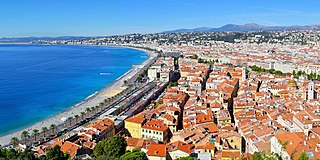
Nice is a city in and the prefecture of the Alpes-Maritimes department in France. The Nice agglomeration extends far beyond the administrative city limits, with a population of nearly one million on an area of 744 km2 (287 sq mi). Located on the French Riviera, the southeastern coast of France on the Mediterranean Sea, at the foot of the French Alps, Nice is the second-largest French city on the Mediterranean coast and second-largest city in the Provence-Alpes-Côte d'Azur region after Marseille. Nice is approximately 13 kilometres (8 mi) from the principality of Monaco and 30 kilometres (19 mi) from the French–Italian border. Nice's airport serves as a gateway to the region.

The Musée des Beaux-Arts de Nice in Nice, France at 33 av. des Baumettes was built in the former private mansion built in 1878 by the Russian Princess, Elizaveta Vasilievna Kochubey. Named for the artist Jules Chéret who lived and worked in Nice during his final years, the museum opened as the "Palais des Arts Jules Chéret" on 7 January 1928.

A samba school is a dancing, marching, and drumming club. They practice and often perform in a huge square-compounds and are devoted to practicing and exhibiting samba, an Afro-Brazilian dance and drumming style. Although the word "school" is in the name, samba schools do not offer instruction in a formal setting. Samba schools have a strong community basis and are traditionally associated with a particular neighborhood. They are often seen to affirm the cultural validity of the Afro-Brazilian heritage in contrast to the mainstream education system, and have evolved often in contrast to authoritarian development. The phrase "escola de samba" is popularly held to derive from the schoolyard location of the first group's early rehearsals. In Rio de Janeiro especially, they are mostly associated with poor neighborhoods ("favelas"). Samba and the samba school can be deeply interwoven with the daily lives of the shanty-town dwellers. Throughout the year the samba schools have various happenings and events, most important of which are rehearsals for the main event which is the yearly carnival parade. Each of the main schools spend many months each year designing the theme, holding a competition for their song, building the floats and rehearsing. It is overseen by a carnavalesco or carnival director. From 2005, some fourteen of the top samba schools in Rio have used a specially designed warehouse complex, the size of ten football pitches, called Samba City to build and house the elaborate floats. Each school's parade may consist of about 3,000 performers or more, and the preparations, especially producing the many different costumes, provide work for thousands of the poorest in Brazilian society. The resulting competition is a major economic and media event, with tens of thousands in the live audience and screened live to millions across South America.

The Barranquilla Carnival is one of Colombia's most important folkloric celebrations, and one of the biggest carnivals in the world. The carnival has traditions that date back to the 19th century. Four days before Lent, Barranquilla decks itself out to receive national and foreign tourists to join together with the city's inhabitants to enjoy four days of intense festivities. During the carnival, Barranquilla's normal activities are put aside as the city gets busy with street dances, musical and masquerade parades. The Carnival Of Barranquilla includes dances such as the Spanish paleo, African Congo, and indigenous mice y mica's. Many styles of Colombian music are also performed, most prominently cumbia, and instruments include drums and wind ensembles. The Carnival of Barranquilla was proclaimed a Cultural Masterpiece of the Nation by Colombia's National Congress in 2002. Also the UNESCO, in Paris on November 7, 2003, declared it one of the Masterpieces of the Oral and Intangible Heritage of Humanity, and it was during Olga Lucia Rodriquez Carnival Queen year.

The Carnival in Rio de Janeiro is a festival held every year before Lent; it is considered the biggest carnival in the world, with two million people per day on the streets. The first Carnival festival in Rio occurred in 1723.
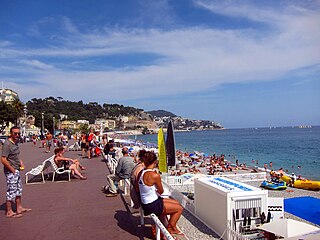
The Promenade des Anglais is a promenade along the Mediterranean coast of Nice, France. It extends from the airport on the west to the Quai des États-Unis on the east, for a distance of approximately 7 km. Administratively speaking, it forms part of Route nationale 98, which runs between Toulon and Menton.

The Paris Carnival is an annual festival held in Paris, France. The carnival occurs after the Feast of Fools and has been held since the 16th century or earlier, with a long 20th century interregnum.
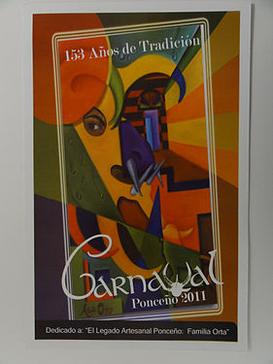
The Carnaval de Ponce, officially Carnaval Ponceño, is an annual celebration of the Carnival holiday held in Ponce, Puerto Rico. The celebration lasts one week, and like most observations of the holiday ends on Fat Tuesday. Thus, like the Carnival holiday in general, it is usually held in February and or March. It dates back to 1858. Some authorities, such as the Smithsonian Institution, believe the Ponce Carnaval can be traced to as far back as 250 years ago. The Carnaval coincides with the Mardi Gras of New Orleans, the Carnival of Venice, and Rio de Janeiro's Carnival and hundreds of other places that observe this holiday around the world. The estimated attendance is 100,000. Scenes of the 2011 Carnaval Ponceño were featured in the Travel Channel on 7 August 2011.
Haitian Carnival is a celebration held over several weeks each year leading up to Mardi Gras. Haitian Defile Kanaval is the Haitian Creole name of the main annual Mardi Gras carnival held in Port-au-Prince, Haiti.
Carnival in Mexico is celebrated by about 225 communities in various ways, with the largest and best known modern celebrations occurring in Mazatlán and the city of Veracruz.

Édouard-Jean Niermans was a famous Dutch-born French architect during the Belle Époque.
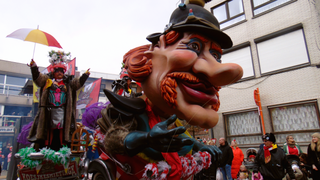
The Carnival of Aalst or Aalst Carnival is an annual three-day event in Aalst, East Flanders, Belgium. The carnival is celebrated in the days preceding Ash Wednesday. It is mainly a street happening; the celebrants dance on the town squares and visit café after café.
The following is a timeline of the history of the city of Nice, France.

On the evening of 14 July 2016, a 19-tonne cargo truck was deliberately driven into crowds of people celebrating Bastille Day on the Promenade des Anglais in Nice, France, resulting in the deaths of 86 people and the injury of 434 others. The driver was Mohamed Lahouaiej-Bouhlel, a Tunisian living in France. The attack ended following an exchange of gunfire, during which he was shot and killed by police.
The Hyatt Regency Nice Palais de la Méditerranée is a nine-floor luxury casino hotel complex located on the Promenade des Anglais in Nice, France. It was built in 1929 by architects Charles and Marcel Dalmas, and partly rebuilt and modernized in 1990, a year after two of its facades were classified as historical monuments. It contains 187 rooms and twelve suites, and is owned by Constellation Hotels Holding.
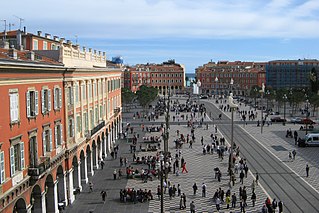
The Place Masséna is a historic square in Nice, Alpes-Maritimes, France. It was named for André Masséna. Its layout was designed by Joseph Vernier in 1843-1844.

Gustav-Adolf Mossa was a French illustrator, playwright, essayist, curator and late Symbolist painter.

The Fête du Citron is a carnival event organised by the tourist office of the city of Menton, France, and held every year at the end of winter. It is also sometimes called Carnaval de Menton.

























